steering wheel Lancia Ypsilon 2003 Owner handbook (in English)
[x] Cancel search | Manufacturer: LANCIA, Model Year: 2003, Model line: Ypsilon, Model: Lancia Ypsilon 2003Pages: 191, PDF Size: 2.45 MB
Page 78 of 191
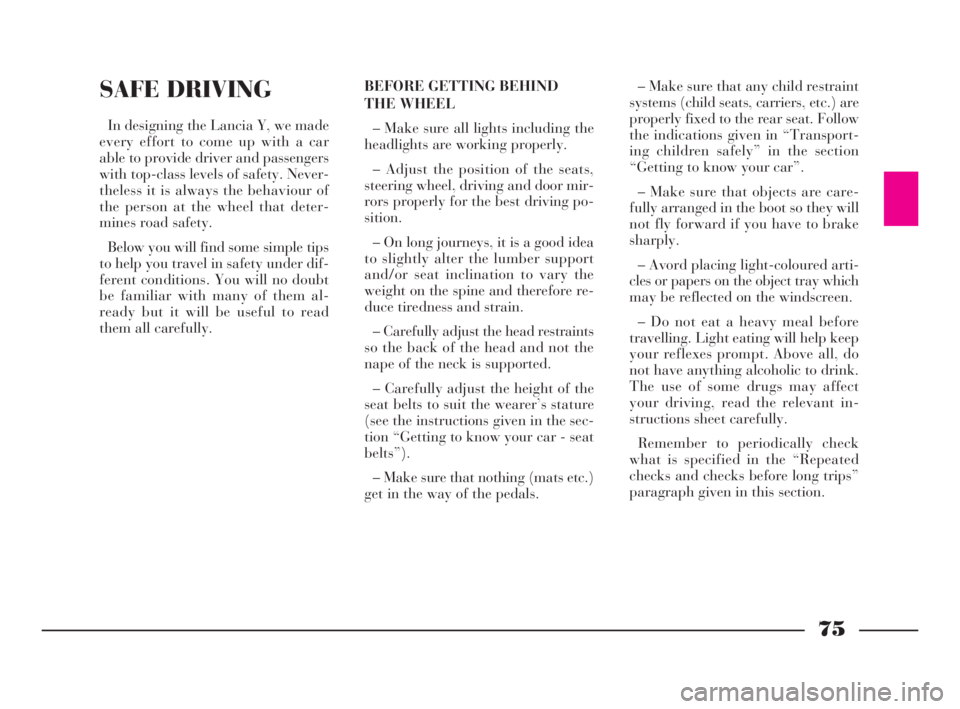
75
G
SAFE DRIVING
In designing the Lancia Y, we made
every effort to come up with a car
able to provide driver and passengers
with top-class levels of safety. Never-
theless it is always the behaviour of
the person at the wheel that deter-
mines road safety.
Below you will find some simple tips
to help you travel in safety under dif-
ferent conditions. You will no doubt
be familiar with many of them al-
ready but it will be useful to read
them all carefully.BEFORE GETTING BEHIND
THE WHEEL
– Make sure all lights including the
headlights are working properly.
– Adjust the position of the seats,
steering wheel, driving and door mir-
rors properly for the best driving po-
sition.
– On long journeys, it is a good idea
to slightly alter the lumber support
and/or seat inclination to vary the
weight on the spine and therefore re-
duce tiredness and strain.
– Carefully adjust the head restraints
so the back of the head and not the
nape of the neck is supported.
– Carefully adjust the height of the
seat belts to suit the wearer’s stature
(see the instructions given in the sec-
tion “Getting to know your car - seat
belts”).
– Make sure that nothing (mats etc.)
get in the way of the pedals.– Make sure that any child restraint
systems (child seats, carriers, etc.) are
properly fixed to the rear seat. Follow
the indications given in “Transport-
ing children safely” in the section
“Getting to know your car”.
– Make sure that objects are care-
fully arranged in the boot so they will
not fly forward if you have to brake
sharply.
– Avord placing light-coloured arti-
cles or papers on the object tray which
may be reflected on the windscreen.
– Do not eat a heavy meal before
travelling. Light eating will help keep
your reflexes prompt. Above all, do
not have anything alcoholic to drink.
The use of some drugs may affect
your driving, read the relevant in-
structions sheet carefully.
Remember to periodically check
what is specified in the “Repeated
checks and checks before long trips”
paragraph given in this section.
4C068-089 ING 11-03-2008 11:59 Pagina 75
Page 80 of 191

77
G
– Only use main-beam headlights
when you are driving outside town
and when you are sure they do not
annoy other drivers.
– Dip your headlights (if on) as soon
as you see cars coming in the other di-
rection and pass them with the head-
lights dipped.
– Keep all lights clean.
– Be careful of animals crossing the
road when driving in the country.
DRIVING IN THE RAIN
Rain and wet road surfaces spell
danger.
All manoeuvres are more difficult on
a wet road because the grip of the
wheels on the tarmac is greatly re-
duced. This is why braking distances
are much longer and roadholding is
lower. DRIVING AT NIGHT
If you are driving at night these are
the main rules to follow:
– Drive especially carefully: it is
harder to drive at night.
– Slow down especially if the road is
not lit.
– At the first signs of sleepiness, stop:
continuing would be a risk for your-
self and everybody else. Only start
driving again when you have had
enough rest.
– Keep a greater safety distance
from the cars in front of you than
during daylight hours: it is hard to
judge how fast other cars are going
when all you can see are their lights.
– Make sure the headlight beams are
properly positioned: if they are too
low, they reduce visibility and strain
your eyes. If they are too high they
can dazzle other drivers. – Do not drive too many hours at a
time but stop at intervals to stretch
your legs and recover your energies.
– Make sure the air in the car is be-
ing changed continuously.
– Never coast downhill (i.e. with the
engine off): if you do, you lose the aid
of engine brake, power brakes and
power steering so that braking and
steering require greater effort.
– Never coast downhill (i.e. with the
engine off): if you do, you lose the aid
of engine braking and power.
4C068-089 ING 11-03-2008 11:59 Pagina 77
Page 97 of 191

94
G
into the catalytic exhaust
pipe and damage it beyond
repair.
BUMP
STARTING
Bump starting by pushing, towing
or rolling downhill must be
avoided at all costs. This way of
starting could cause a rush of fuelRemember that as long as
the engine is not running,
the brake booster and
power steering do not work. You
therefore have to use considerably
more effort on both the brake
pedal and the steering wheel.
IF A TYRE
IS
PUNCTURED
GENERAL INDICATIONS
The following precautions must be
observed when changing a wheel and
using the jack and the space-saver
spare wheel.
4C090-119 ING 11-03-2008 12:00 Pagina 94
Page 111 of 191
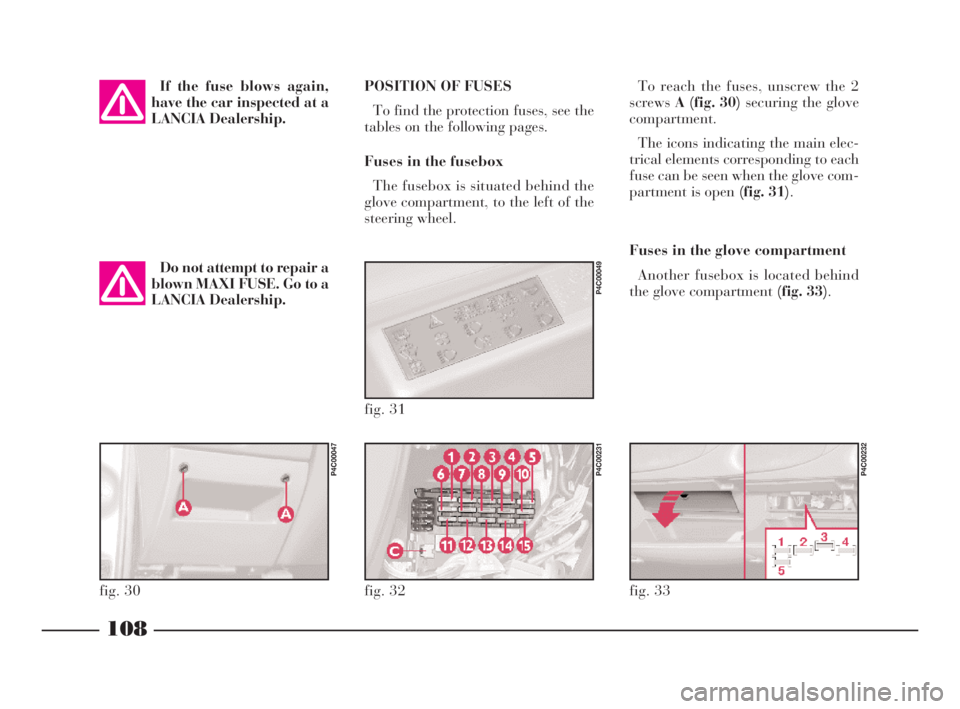
108
fG
POSITION OF FUSES
To find the protection fuses, see the
tables on the following pages.
Fuses in the fusebox
The fusebox is situated behind the
glove compartment, to the left of the
steering wheel.To reach the fuses, unscrew the 2
screwsA (fig. 30) securing the glove
compartment.
The icons indicating the main elec-
trical elements corresponding to each
fuse can be seen when the glove com-
partment is open (fig. 31).
Fuses in the glove compartment
Another fusebox is located behind
the glove compartment (fig. 33).
fig. 32
P4C00231
fig. 33
P4C00232
fig. 31
P4C00049
fig. 30
P4C00047
If the fuse blows again,
have the car inspected at a
LANCIA Dealership.
Do not attempt to repair a
blown MAXI FUSE. Go to a
LANCIA Dealership.
4C090-119 ING 13-03-2008 12:51 Pagina 108
Page 120 of 191

117
fG
While the car is being
towed with the engine off,
remember that the brake
pedal and steering will require
more effort as you no longer have
the benefit of the brake booster
and power steering. Do not use
flexible cables to tow. Avoid jerk-
ing. Whilst towing, ensure that the
coupling to the car does not dam-
age the surrounding components.Do not extract the igni-
tion key during towing;
leave it at MAR, to prevent
the steering lock engaging and,
provided the electrical system is
not damaged, keep the brake lights
and direction indicators working.
When the ignition key is re-
moved, the steering lock will cut in
thus preventing the steering wheel
from being turned.IF AN ACCIDENT
OCCURS
– It is important to keep calm.
– If you are not directly involved,
stop at least ten metres away from the
accident.
– If you are on a motorway do not
obstruct the emergency lane with your
car.
– Turn off the engine and turn on
the hazard lights.
– At night, illuminate the scene of
the accident with your headlights.
– Act carefully, you must not risk
being run over.
– Mark the accident by putting the
red triangle at the regulatory distance
from the car where it can be clearly
seen.
– If the doors are jammed, do not try
to leave the car by breaking the glass
of the windscreen as the glass is strat-
ified. Side windows and the rear win-
dow can be broken more easily.
4C090-119 ING 13-03-2008 12:51 Pagina 117
Page 127 of 191
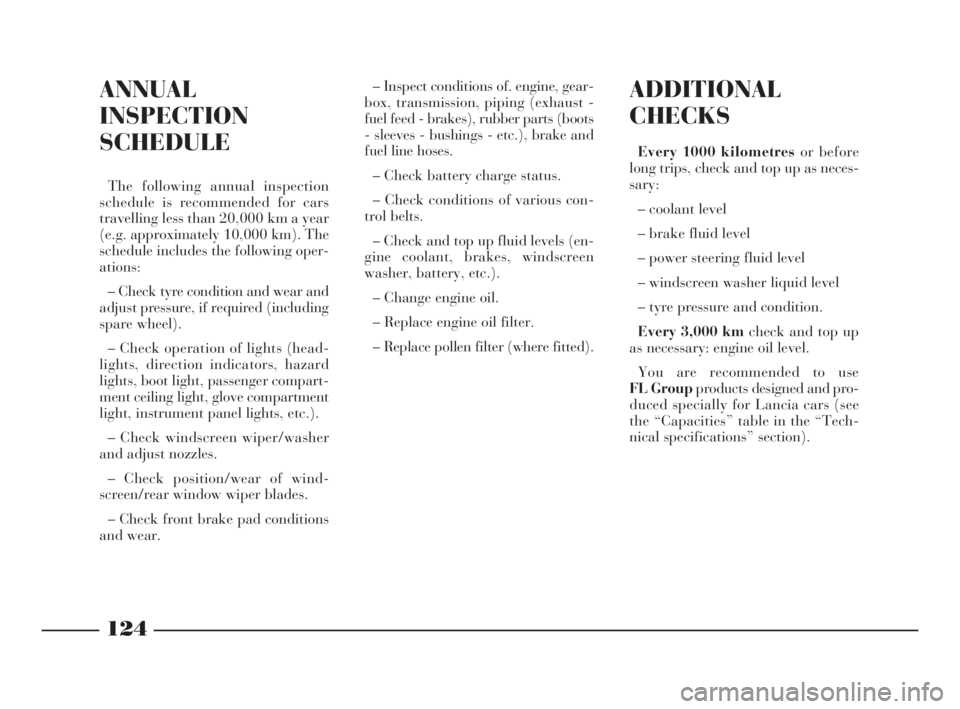
124
G
ADDITIONAL
CHECKS
Every 1000 kilometres or before
long trips, check and top up as neces-
sary:
– coolant level
– brake fluid level
– power steering fluid level
– windscreen washer liquid level
– tyre pressure and condition.
Every 3,000 kmcheck and top up
as necessary: engine oil level.
You are recommended to use
FL Groupproducts designed and pro-
duced specially for Lancia cars (see
the “Capacities” table in the “Tech-
nical specifications” section).
ANNUAL
INSPECTION
SCHEDULE
The following annual inspection
schedule is recommended for cars
travelling less than 20,000 km a year
(e.g. approximately 10,000 km). The
schedule includes the following oper-
ations:
– Check tyre condition and wear and
adjust pressure, if required (including
spare wheel).
– Check operation of lights (head-
lights, direction indicators, hazard
lights, boot light, passenger compart-
ment ceiling light, glove compartment
light, instrument panel lights, etc.).
– Check windscreen wiper/washer
and adjust nozzles.
– Check position/wear of wind-
screen/rear window wiper blades.
– Check front brake pad conditions
and wear.– Inspect conditions of. engine, gear-
box, transmission, piping (exhaust -
fuel feed - brakes), rubber parts (boots
- sleeves - bushings - etc.), brake and
fuel line hoses.
– Check battery charge status.
– Check conditions of various con-
trol belts.
– Check and top up fluid levels (en-
gine coolant, brakes, windscreen
washer, battery, etc.).
– Change engine oil.
– Replace engine oil filter.
– Replace pollen filter (where fitted).
4C120-143 ING 11-03-2008 12:01 Pagina 124
Page 140 of 191

137
G
If you get a flat tyre, stop immedi-
ately and change it so as not to dam-
age the tyre, the wheel, the suspension
and the steering.
Tyres age even if they are not used
very much. Cracking of the tread rub-
ber and the side walls are a sign of
this ageing. In any case, if the tyres
have been fitted for more than six
years they should be examined by an
expert who can judge whether they
are still fit for use. Remember to
check the spare tyre particularly care-
fully too.
If a replacement is necessary, always
use new tyres and avoid using ones
the origin of which you are not certain
about.
Lancia Y uses tubeless tyres. Under
no circumstances should an inner
tube be used with these tyres.
If you replace a tyre it is a good idea
to change the inflation valve, too.To ensure the front and rear tyres all
wear evenly, you are advised to
change the tyres over every 10-15
thousand kilometres keeping them on
the same side of the car so as not to
reverse the direction of rotation.RUBBER TUBING
Follow the Service Schedule care-
fully in the case of the braking and
fuel supply systems rubber hoses.
Ozone, high temperatures and long
absence of liquid in the system can in
fact cause the hardening and crack-
ing of the pipes with possible loss of
fluid. A careful check is therefore es-
sential.
Do not change the tyres
over in criss-cross fashion
by moving a tyre from the
left hand side of the car to the right
and vice versa.
4C120-143 ING 11-03-2008 12:01 Pagina 137
Page 147 of 191
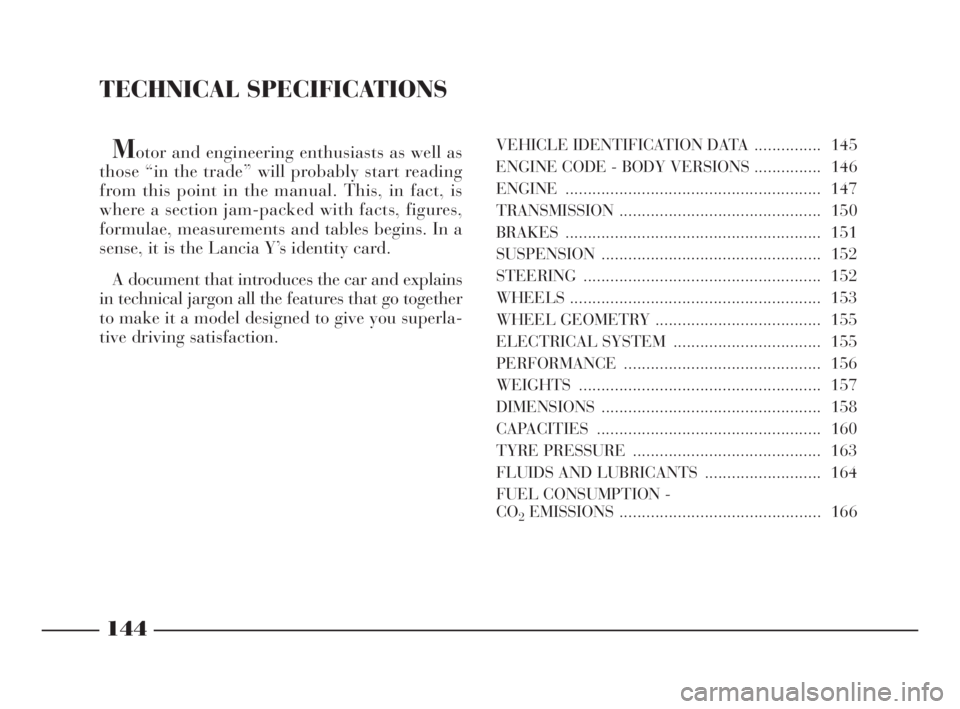
TECHNICAL SPECIFICATIONS
Motor and engineering enthusiasts as well as
those “in the trade” will probably start reading
from this point in the manual. This, in fact, is
where a section jam-packed with facts, figures,
formulae, measurements and tables begins. In a
sense, it is the Lancia Y’s identity card.
A document that introduces the car and explains
in technical jargon all the features that go together
to make it a model designed to give you superla-
tive driving satisfaction.VEHICLE IDENTIFICATION DATA ............... 145
ENGINE CODE - BODY VERSIONS............... 146
ENGINE......................................................... 147
TRANSMISSION............................................. 150
BRAKES......................................................... 151
SUSPENSION ................................................. 152
STEERING..................................................... 152
WHEELS........................................................ 153
WHEEL GEOMETRY ..................................... 155
ELECTRICAL SYSTEM ................................. 155
PERFORMANCE............................................ 156
WEIGHTS...................................................... 157
DIMENSIONS................................................. 158
CAPACITIES .................................................. 160
TYRE PRESSURE .......................................... 163
FLUIDS AND LUBRICANTS .......................... 164
FUEL CONSUMPTION -
CO
2EMISSIONS ............................................. 166
144
G
4C144-167 ING 11-03-2008 12:02 Pagina 144
Page 155 of 191
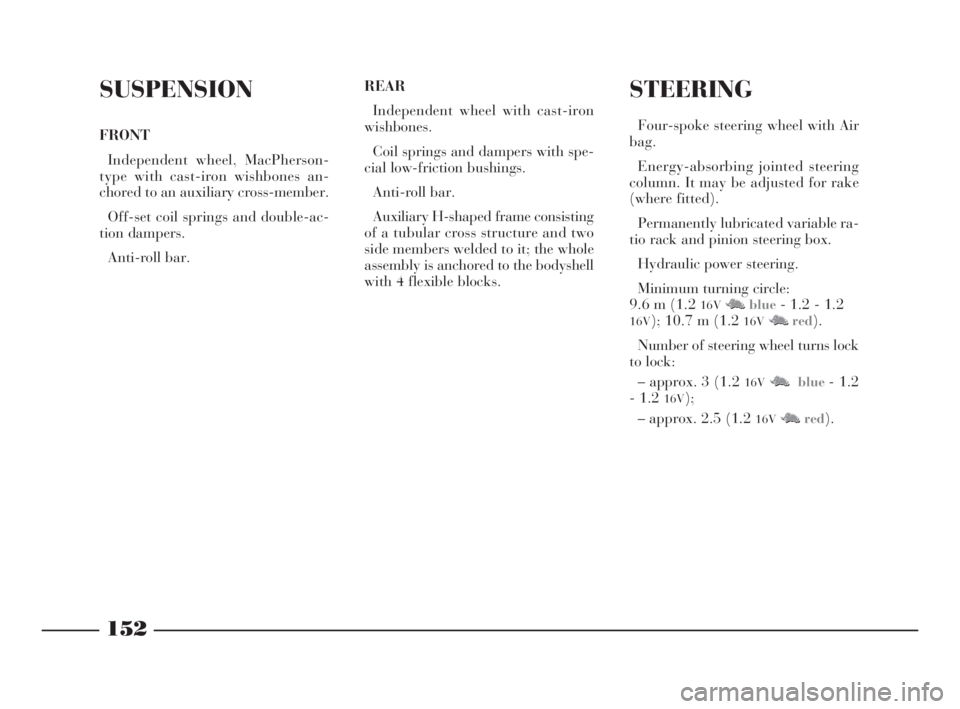
STEERING
Four-spoke steering wheel with Air
bag.
Energy-absorbing jointed steering
column. It may be adjusted for rake
(where fitted).
Permanently lubricated variable ra-
tio rack and pinion steering box.
Hydraulic power steering.
Minimum turning circle:
9.6 m (1.2
16VM Nblue- 1.2 - 1.2
16V); 10.7 m (1.2 16VM Nred).
Number of steering wheel turns lock
to lock:
– approx. 3 (1.2
16VM Nblue- 1.2
- 1.2
16V);
– approx. 2.5 (1.2
16VM Nred).
152
G
SUSPENSION
FRONT
Independent wheel, MacPherson-
type with cast-iron wishbones an-
chored to an auxiliary cross-member.
Off-set coil springs and double-ac-
tion dampers.
Anti-roll bar.REAR
Independent wheel with cast-iron
wishbones.
Coil springs and dampers with spe-
cial low-friction bushings.
Anti-roll bar.
Auxiliary H-shaped frame consisting
of a tubular cross structure and two
side members welded to it; the whole
assembly is anchored to the bodyshell
with 4 flexible blocks.
4C144-167 ING 11-03-2008 12:02 Pagina 152
Page 163 of 191
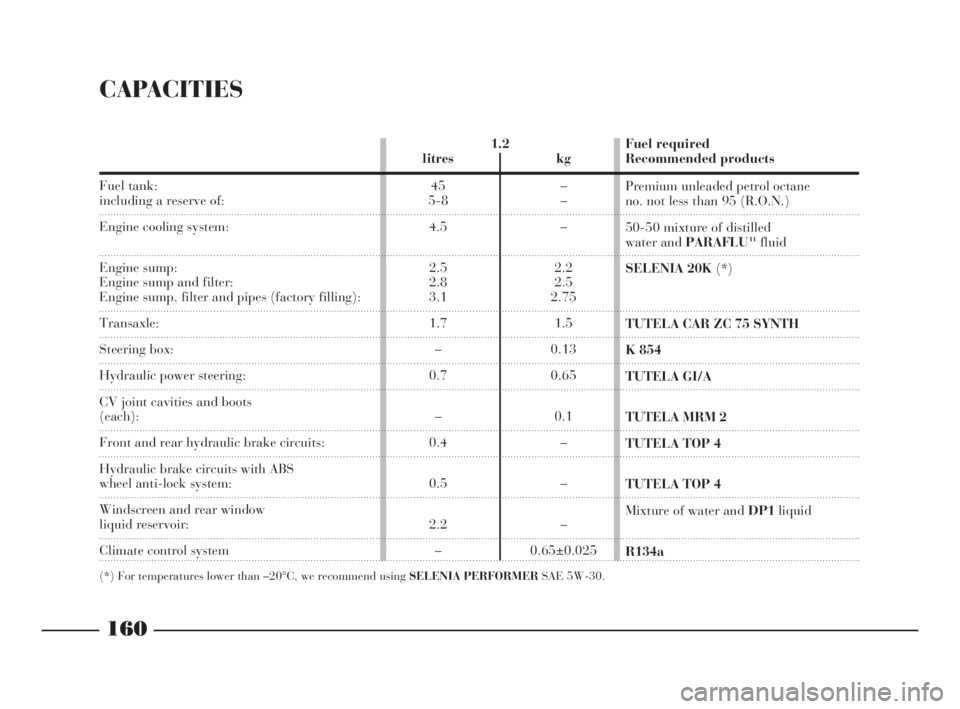
160
G
CAPACITIES
Fuel tank:including a reserve of:
Engine cooling system:
Engine sump:
Engine sump and filter:
Engine sump, filter and pipes (factory filling):
Transaxle:
Steering box:
Hydraulic power steering:
CV joint cavities and boots
(each):
Front and rear hydraulic brake circuits:
Hydraulic brake circuits with ABS
wheel anti-lock system:
Windscreen and rear window
liquid reservoir:
Climate control system
(*) For temperatures lower than –20°C, we recommend using SELENIA PERFORMERSAE 5W-30.
1.2
litres kg
45 –
5-8 –
4.5 –
2.5 2.2
2.8 2.5
3.1 2.75
1.7 1.5
–0.13
0.7 0.65
– 0.1
0.4 –
0.5 –
2.2 –
– 0.65±0.025Fuel required
Recommended products
Premium unleaded petrol octane
no. not less than 95 (R.O.N.)
50-50 mixture of distilled
water and PARAFLU
11fluid
SELENIA 20K(*)
TUTELA CAR ZC 75 SYNTH
K 854
TUTELA GI/A
TUTELA MRM 2
TUTELA TOP 4
TUTELA TOP 4
Mixture of water and DP1liquid
R134a
rs
4C144-167 ING 11-03-2008 12:02 Pagina 160